第三章核磁共振波谱_第三部分
- 格式:ppt
- 大小:1003.00 KB
- 文档页数:19
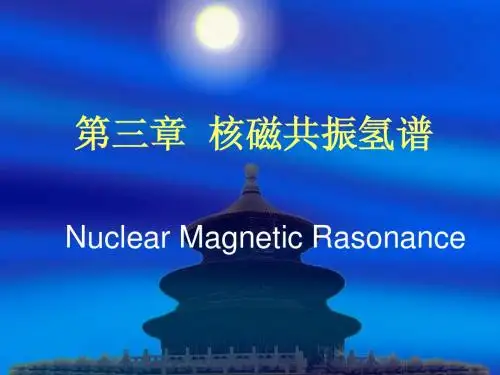
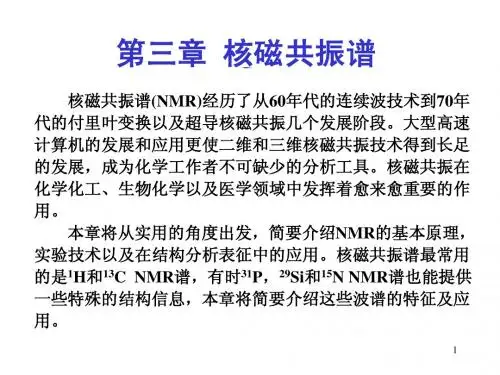
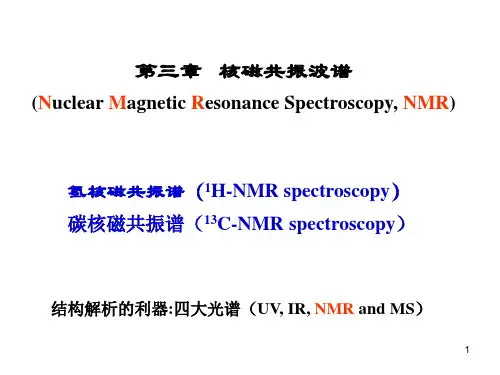
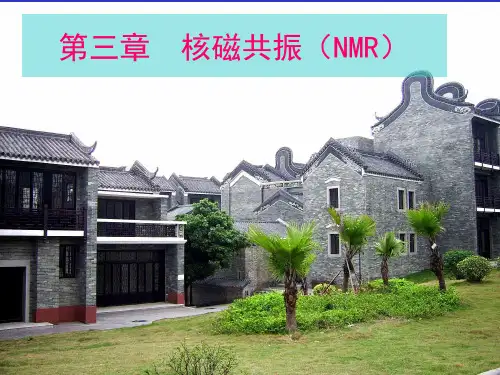
![[核磁共振共振波谱学讲义]第三章—NMR实验技术基础(2数据采集)](https://uimg.taocdn.com/fef85b9d51e79b8968022696.webp)
第三章 NMR 实验技术基础2 数据采集在现代脉冲Fourier 变换核磁谱仪上,核磁矩在一系列脉冲作用下产生横向磁化,横向磁化围绕外磁场进动并在探头的检测线圈中产生感生电流,经放大及ADC 数字化后记录下来。
这种时域信号称为FID(free-induction decay)或interferogram 。
前者专门指检测线圈中检测到的信号,后者既可指FID ,也可指多维谱中间接维中检测的信号。
数字化的FID 通常经Fourier 变换产生对应的频域信号即通常意义上的核磁共振谱,数字化处理是现代脉冲Fourier 变换核磁谱仪的一个典型特征。
a 采样定理在信号处理中最常用也最容易实现的是周期采样,即采样的时间间隔固定。
记时间间隔为∆t,有著名的采样定理:若一个连续时域信号的最高频率成分的频率不超过f c ,则周期采样信号系列S(k ∆t)能再现原信号的条件是:12∆t f c ≥ 通常称f tn =12∆为Nyquist frequency 换一种说法,采样频率不能低于信号最高频率的2倍。
(1) 满足采样定理时,原信号可由离散信号系列S(k ∆t)复原:s t S k t c ft k t n k ()()sin {()}=-=-∞∞∑∆∆2π 此处sin ()sin()c x x x =可检测到的最高信号频率为±采样频率/2,其间隔称为谱宽: SW f tn ==21∆ (2) 当信号频率超过Nyquist 频率时,将产生折叠现象(folding/aliasing),在频谱上表现为谱宽范围内的一个信号,如:当时域信号为复数系列时:两个频率成分νν02=+mf n a 与νa 在频谱上出现在同一位置. 前者的时域信号为:Ae Ae Ae Ae Ae Ae Ae Ae Ae i t i t i t i mf t i mf t i t i m i t i t n a n a a a ωθπνθπνθπνθππνθππνθπνθ++++++++======22222222220()这正是后者的时域信号,因而两种频率成分在时域的离散采样不可区分,也就是说,一个离散时间系列变换到的频谱具有有限带宽。
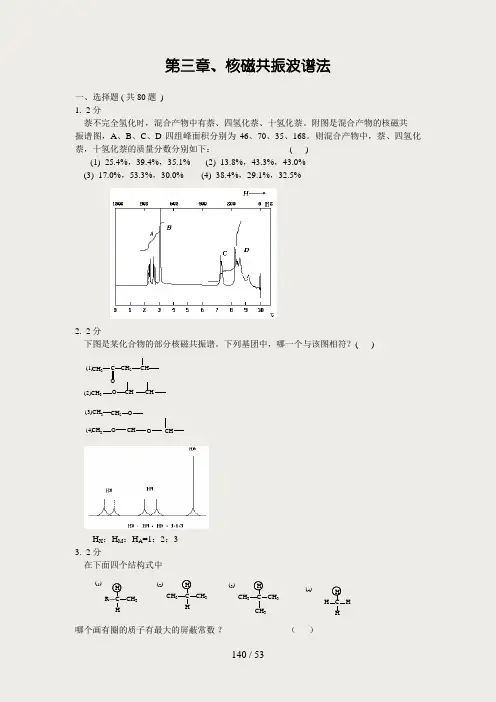
第三章、核磁共振波谱法一、选择题 ( 共80题 ) 1. 2 分萘不完全氢化时,混合产物中有萘、四氢化萘、十氢化萘。
附图是混合产物的核磁共 振谱图,A 、B 、C 、D 四组峰面积分别为 46、70、35、168。
则混合产物中,萘、四氢化萘,十氢化萘的质量分数分别如下: ( ) (1) 25.4%,39.4%,35.1% (2) 13.8%,43.3%,43.0% (3) 17.0%,53.3%,30.0% (4) 38.4%,29.1%,32.5%2. 2 分下图是某化合物的部分核磁共振谱。
下列基团中,哪一个与该图相符?( )(1)CH 3C CH 2OCHCH O CH3(2)CH (3)CH 3CH 2O (4)C H 3OCHOCHH X :H M :H A =1:2:3 3. 2 分在下面四个结构式中(1)C CH 3HR H (2)H C CH 3HCH 3(3)H C CH 3CH 3CH 3(4)H C HHH哪个画有圈的质子有最大的屏蔽常数 ? ( )4. 1 分一个化合物经元素分析,含碳 88.2%,含氢 11.8%,其氢谱只有一个单峰。
它是 下列可能结构中的哪一个? ( )5. 1 分下述原子核中,自旋量子数不为零的是 ( ) (1) F (2) C (3) O (4) He 6. 2 分在 CH 3- CH 2- CH 3分子中,其亚甲基质子峰精细结构的强度比为哪一组数据 ?( ) (1) 1 : 3 : 3 : 1 (2) 1 : 4 : 6 : 6 : 4 : 1(3) 1 : 5 : 10 : 10 : 5 : 1 (4) 1 : 6 : 15 : 20 : 15 : 6 : 1 7. 2 分ClCH 2- CH 2Cl 分子的核磁共振图在自旋-自旋分裂后,预计 ( ) (1) 质子有 6 个精细结构 (2) 有 2 个质子吸收峰 (3) 不存在裂分 (4) 有 5 个质子吸收峰 8. 2 分在 O - H 体系中,质子受氧核自旋-自旋偶合产生多少个峰 ? ( ) (1) 2 (2) 1 (3) 4 (4) 3 9. 2 分在 CH 3CH 2Cl 分子中何种质子 σ 值大 ? ( )(1) CH 3- 中的 (2) CH 2- 中的 (3) 所有的 (4) 离 Cl 原子最近的 10. 2 分在 60 MHz 仪器上,TMS 和一物质分子的某质子的吸收频率差为 120Hz ,则该质 子的化学位移为 ( ) (1) 2 (2) 0.5 (3) 2.5 (4) 4 11. 2 分下图四种分子中,带圈质子受的屏蔽作用最大的是 ( )C HHHH RC RRH H C RH HH RC RHHH (b)(c)(d)(a) 12. 2 分质子的γ(磁旋比)为 2.67×108/(T •s),在外场强度为 B 0 = 1.4092T时,发生核磁共 振的辐射频率应为 ( )(1) 100MHz (2) 56.4MHz (3) 60MHz (4) 24.3MHz 13. 2 分下述原子核没有自旋角动量的是 ( )(1) Li 73 (2) C 136 (3) N 147 (4) C 12614. 1 分将 H 11 放在外磁场中时,核自旋轴的取向数目为 ( )(1) 1 (2) 2 (3) 3 (4) 5 15. 2 分核磁共振波谱法中乙烯, 乙炔, 苯分子中质子化学位移值序是 ( ) (1) 苯 > 乙烯 > 乙炔 (2) 乙炔 > 乙烯 > 苯 (3) 乙烯 > 苯 > 乙炔 (4) 三者相等 16. 1 分用核磁共振波谱法测定有机物结构, 试样应是 ( ) (1) 单质 (2) 纯物质 (3) 混合物 (4) 任何试样 17. 2 分在下列化合物中,核磁共振波谱, OH 基团的质子化学位移值最大的是 (不考虑 氢键影响) ( )(1) R OH (2) R COOH (3)OH (4)CH 2OH18. 2 分对乙烯与乙炔的核磁共振波谱, 质子化学位移(δ )值分别为5.8与2.8, 乙烯 质子峰化学位移值大的原因是 ( )(1) 诱导效应 (2) 磁各向异性效应 (3) 自旋─自旋偶合 (4) 共轭效应 19. 2 分某化合物分子式为C 10H 14, 1HNMR 谱图如下: 有两个单峰 a 峰δ= 7.2 , b 峰δ= 1.3峰面积之比: a:b=5:9 试问结构式为 ( )CH 2CH(CH 3)2CH(CH 3)CH 2CH 3C(CH 3)3CH 3CH(CH 3)2(1)(2)(3)(4 )20. 2 分化合物C 4H 7Br 3的1HNMR 谱图上,有两组峰都是单峰: a 峰 δ= 1.7 , b 峰 δ= 3.3,峰面积之比: a:b=3:4 它的结构式是 ( ) (1) CH 2Br-CHBr-CHBr-CH 3 (2) CBr 3-CH 2-CH 2-CH 3CBrCHBr 2CH 3CH 3(3)C BrCH 3CH 2Br CH 2Br(4)21. 2 分某化合物经元素分析, 含碳88.2%, 含氢11.8%, 1HNMR 谱图上只有一个单峰, 它的结构式是 ( )C CH 2CH 2CH 2CH 2CH CHCH CHC H 2H 2CCHCHC CH 2CH 2CH 2CH 2(1)(3)(2)(4)22. 2 分丙烷 C H C H H H C HHH H , 1HNMR 谱其各组峰面积之比(由高场至低场)是( ) (1) 3:1 (2) 2:3:3 (3) 3:2:3 (4) 3:3:2 23. 2 分核磁共振波谱法, 从广义上说也是吸收光谱法的一种, 但它同通常的吸收光谱法 (如紫外、 可见和红外吸收光谱)不同之处在于 ( ) (1) 必须有一定频率的电磁辐射照射 (2) 试样放在强磁场中 (3) 有信号检测仪 (4) 有记录仪 24. 2 分对核磁共振波谱法, 绕核电子云密度增加, 核所感受到的外磁场强度会( ) (1) 没变化 (2) 减小 (3) 增加 (4) 稍有增加 25. 2 分核磁共振波谱的产生, 是将试样在磁场作用下, 用适宜频率的电磁辐射照射, 使下列哪种粒子吸收能量, 产生能级跃迁而引起的 ( ) (1) 原子 (2) 有磁性的原子核 (3) 有磁性的原子核外电子 (4) 所有原子核 26. 2 分核磁共振的弛豫过程是 ( ) (1) 自旋核加热过程(2) 自旋核由低能态向高能态的跃迁过程(3) 自旋核由高能态返回低能态, 多余能量以电磁辐射形式发射出去 (4) 高能态自旋核将多余能量以无辐射途径释放而返回低能态 27. 2 分核磁共振波谱的产生, 是由于在强磁场作用下, 由下列之一产生能级分裂, 吸收一定频率电磁辐射, 由低能级跃迁至高能级 ( ) (1) 具有磁性的原子 (2) 具有磁性的原子核(3) 具有磁性的原子核外电子 (4) 具有磁性的原子核内电子 28. 1 分核磁共振波谱法所用电磁辐射区域为 ( ) (1) 远紫外区 (2) X 射线区 (3) 微波区 (4) 射频区 29. 2 分613C 自旋量子数I =1/2将其放在外磁场中有几种取向(能态) ( )(1) 2 (2) 4 (3) 6 (4) 8 30. 2 分将511B (其自旋量子数I =3/2) 放在外磁场中,它有几个能态 ( ) (1) 2 (2) 4 (3) 6 (4) 8 31. 2 分某一个自旋核, 产生核磁共振现象时, 吸收电磁辐射的频率大小取决于( ) (1) 试样的纯度 (2) 在自然界的丰度 (3) 试样的存在状态 (4) 外磁场强度大小 32. 2 分613C(磁矩为μC )在磁场强度为H 0的磁场中时, 高能级与低能级能量之差∆( )(1)μC B 0 (2) 2μC B 0 (3) 4μC B 0 (4) 6μC B 0 33. 2 分自旋核在外磁场作用下, 产生能级分裂, 其相邻两能级能量之差为( ) (1) 固定不变 (2) 随外磁场强度变大而变大 (3) 随照射电磁辐射频率加大而变大 (4) 任意变化 34. 2 分化合物C 3H 5Cl 3, 1HNMR 谱图上有3组峰的结构式是 ( ) (1) CH 3-CH 2-CCl 3 (2) CH 3-CCl 2-CH 2Cl (3) CH 2Cl-CH 2-CH 2Cl (4) CH 2Cl-CH 2-CHCl 2 35. 2 分化合物C 3H 5Cl 3, 1HNMR 谱图上有两个单峰的结构式是 ( ) (1) CH 3-CH 2-CCl 3 (2) CH 3-CCl 2-CH 2Cl(3) CH 2Cl-CH 2-CHCl 2 (4) CH 2Cl-CHCl-CH 2Cl 36. 2 分某化合物的1HNMR 谱图上, 出现两个单峰, 峰面积之比(从高场至低场)为3:1 是下列结构式中 ( ) (1) CH 3CHBr 2 (2) CH 2Br-CH 2Br(3) CHBr 2-CH 2Br (4) CH 2Br-CBr(CH 3)2 37. 2 分化合物(CH 3)2CHCH 2CH(CH 3)2, 在1HNMR 谱图上, 从高场至低场峰面积 之比为 ( ) (1) 6:1:2:1:6 (2) 2:6:2 (3) 6:1:1 (4) 6:6:2:2 38. 2 分化合物Cl-CH2-CH2-Cl1HNMR谱图上为 ( )(1) 1个单峰 (2) 1个三重峰 (3) 2个二重峰 (4) 2个三重峰39. 2 分某化合物Cl-CH2-CH2-CH2-Cl1HNMR谱图上为 ( )(1) 1个单峰 (2) 3个单峰(3) 2组峰: 1个为单峰, 1个为二重峰 (4) 2组峰: 1个为三重峰, 1个为五重峰40. 2 分2-丁酮CH3COCH2CH3, 1HNMR谱图上峰面积之比(从高场至低场)应为()(1) 3:1 (2) 3:3:2 (3) 3:2:3 (4) 2:3:341. 2 分在下列化合物中, 用字母标出的亚甲基和次甲基质子的化学位移值从大到小的顺序是 ( )CH3CH2CH3 CH3CH(CH3)2 CH3CH2Cl CH3CH2Br(a) (b) (c) (d)(1) a b c d (2) a b d c (3) c d a b (4) c d b a42. 2 分考虑2-丙醇CH3CH(OH)CH3的NMR谱, 若醇质子是快速交换的, 那么下列预言中正确的是 ( )(1) 甲基是单峰, 次甲基是七重峰, 醇质子是单峰(2) 甲基是二重峰, 次甲基是七重峰, 醇质子是单峰(3)甲基是四重峰, 次甲基是七重峰, 醇质子是单峰(4) 甲基是四重峰, 次甲基是十四重峰, 醇质子是二重峰(假定仪器的分辨率足够)43. 2 分在下列化合物中, 用字母标出的4种质子的化学位移值( )从大到小的顺序是()CH3CH2OH Ca bcd(1) d c b a (2) a b c d(3) d b c a (4) a d b c44. 2 分考虑3,3-二氯丙烯(CH2=CH-CHCl2)的NMR谱, 假如多重峰没有重叠且都能分辨,理论上正确的预言是 ( )(1) 有3组峰, 2位碳上的质子是六重峰(2) 有3组峰, 2位碳上的质子是四重峰(3) 有4组峰, 2位碳上的质子是八重峰(4) 有4组峰, 2位碳上的质子是六重峰45. 2 分一种纯净的硝基甲苯的NMR图谱中出现了3组峰, 其中一个是单峰, 一组是二重峰, 一组是三重峰. 该化合物是下列结构中的 ( )(a)CH 3CH 3NO 2O 2NCH 3NO 2O 2N CH 3NO 2NO 2NO 2NO 2(b)(c)(d)46. 2 分考虑α-呋喃甲酸甲酯(糠醛甲酯)的核磁共振谱, 若仪器的分辨率足够, 下列预言中正 确的是 ( )OC OOCH 3(1) 4个单峰, 峰面积比是1:1:1:3(2) 4组峰, 其中一个是单峰, 另外3组峰均是二重峰(3) 4组峰, 其中一个是单峰, 另外3组峰均是四重峰, 多重峰的面积比是1:1:1:1 (4) 4重峰, 同(3), 但多重峰面积比是1:3:3:147. 2 分在下列化合物中标出了a 、b 、c 、d 4种质子, 处于最低场的质子是 ( )CH 3CCH 3CH 3Odb ca 48. 2 分化合物CH 3COCH 2COOCH 2CH 3 的1HNMR 谱的特点是( ) (1) 4个单峰(2) 3个单峰, 1个三重峰 (3) 2个单峰(4) 2个单峰, 1个三重峰和1 个四重峰 49. 2 分化合物CH 3CH 2OCOCOCH 2CH 3 的1HNMR 谱的特点是( ) (1) 4个单峰 (2) 2个单峰(3) 2个三重峰, 2个四重峰 (4) 1个三重峰, 1 个四重峰 50. 2 分测定某有机化合物中某质子的化学位移值δ在不同的条件下, 其值( ) (1) 磁场强度大的δ大 (2) 照射频率大的δ大(3) 磁场强度大, 照射频率也大的δ大(4) 不同仪器的 相同 51. 1 分外磁场强度增大时,质子从低能级跃迁至高能级所需的能量( ) (1) 变大 (2) 变小 (3) 逐渐变小 (4) 不变化 52. 1 分自旋核的磁旋比γ随外磁场强度变大而( ) (1) 变大 (2) 变小 (3) 稍改变 (4) 不改变 53. 1 分表示原子核磁性大小的是( )(1) 自旋量子数 (2) 磁量子数 (3) 外磁场强度 (4) 核磁矩 54. 1 分核磁共振波谱法中, 化学位移的产生是由于( )造成的。
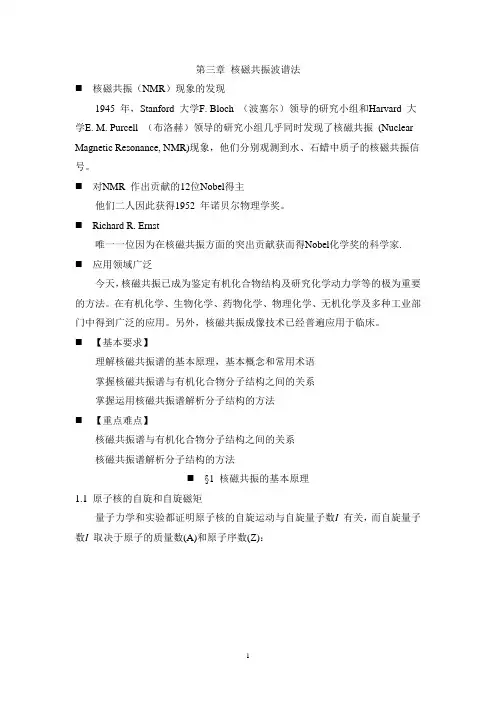
第三章核磁共振波谱法⏹核磁共振(NMR)现象的发现1945 年,Stanford 大学F. Bloch (波塞尔)领导的研究小组和Harvard 大学E. M. Purcell (布洛赫)领导的研究小组几乎同时发现了核磁共振(Nuclear Magnetic Resonance, NMR)现象,他们分别观测到水、石蜡中质子的核磁共振信号。
⏹对NMR 作出贡献的12位Nobel得主他们二人因此获得1952 年诺贝尔物理学奖。
⏹Richard R. Ernst唯一一位因为在核磁共振方面的突出贡献获而得Nobel化学奖的科学家.⏹应用领域广泛今天,核磁共振已成为鉴定有机化合物结构及研究化学动力学等的极为重要的方法。
在有机化学、生物化学、药物化学、物理化学、无机化学及多种工业部门中得到广泛的应用。
另外,核磁共振成像技术已经普遍应用于临床。
⏹【基本要求】理解核磁共振谱的基本原理,基本概念和常用术语掌握核磁共振谱与有机化合物分子结构之间的关系掌握运用核磁共振谱解析分子结构的方法⏹【重点难点】核磁共振谱与有机化合物分子结构之间的关系核磁共振谱解析分子结构的方法⏹§1 核磁共振的基本原理1.1 原子核的自旋和自旋磁矩量子力学和实验都证明原子核的自旋运动与自旋量子数I 有关,而自旋量子数I 取决于原子的质量数(A)和原子序数(Z):原子核是由中子与质子组成。
质子与中子数为偶数的核,其自旋量子数I=0,没有自旋运动,例如12C、18O、32S等核。
质子数与中子数其中之一为奇数I≠0,具有自旋现象,例如1H、13C、19F、31P、14N、35Cl等核。
(质子数=核电荷数=原子序数)⏹自旋量子数I ≠ 0 的原子核都有自旋运动,并且核带有一定的正电荷。
这些电荷也围绕着自旋轴旋转,从而产生循环电流,循环电流就会产生磁场。
因此凡是I ≠ 0的原子核都会产生磁矩。
其自旋磁矩μ = γ P。
μ是一个矢量,其方向与自旋轴重合;γ为磁旋比,代表磁核的性质,是核的特征常数。
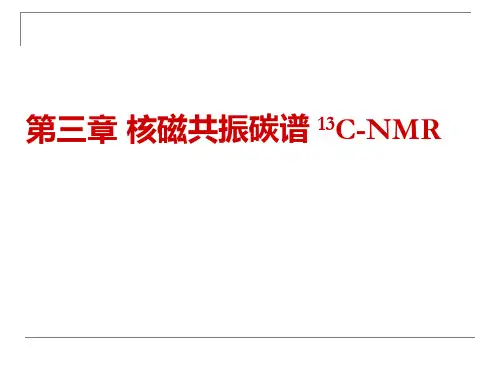

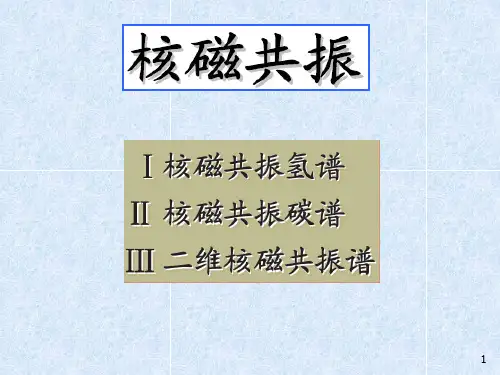
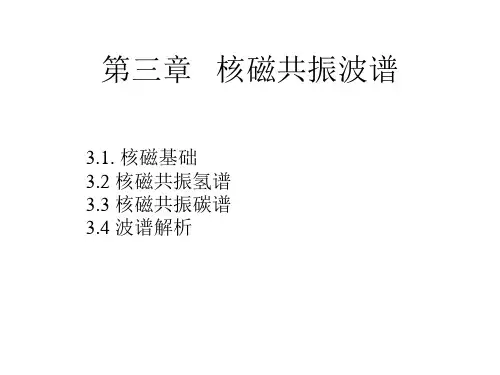
第三章 NMR 实验技术基础1 NMR 仪器如图,现代超导核磁谱仪的主要组成部分包括:1. 超导磁体Magnet 包括Field Lock ,Shim Coils2. 探头Probe 内有RF Coils ,Gradient Coils3. 脉冲编程器及射频放大器4. 接收器5. 数据采集及处理计算机At the top of the schematic representation, you will find the superconducting magnet of the NMR spectrometer. The magnet produces the Bo field necessary for the NMR experiments. Immediately within the bore of the magnet are the shim coils for homogenizing the Bo field.Within the shim coils is the probe. The probe contains the RF coils for producing the B1 magnetic field necessary to rotate the spins. The RF coil also detects the signal from the spins within the sample. The sample is positioned within the RF coil of the probe. Some probes also contain a set of gradient coils. These coils produce a gradient in Bo along the X, Y , or Z axis. Gradient coils are used for for gradient enhanced spectroscopy, diffusion, and NMR microscopy experiments. The heart of the spectrometer is the computer. It controls all of the components of thespectrometer. The RF components under control of the computer are the RF frequency source and pulse programmer. The source produces a sine wave of the desired frequency. The pulse programmer sets the width, and in some cases the shape, of the RF pulses. The RF amplifier increases the pulses power from milli Watts to tens or hundreds of Watts. The computer alsocontrols the gradient pulse programmer which sets the shape and amplitude of gradient fields. The gradient amplifier increases the power of the gradient pulses to a level sufficient to drive the gradient coils. The operator of the spectrometer gives input to the computer through a console terminal with a mouse and keyboard. Some spectrometers also have a separate small interface for carrying out some of the more routine procedures on the spectrometer. A pulse sequence isselected and customized from the console terminal. The operator can see spectra on a video display located on the console and can make hard copies of spectra using a printer.1. 超导磁体MagnetMagnet主要要求:a 高磁场强度,分辨率与B0成正比,而灵敏度与B032成正比,故750MHz较600MHz的分辨率提高25%,而灵敏度提高40%b 高均匀性,目前可达10-9c 高稳定性The NMR magnet is one of the mostexpensive components of the nuclearmagnetic resonance spectrometer system.Most magnets are of the superconductingtype. A superconducting magnet has anelectromagnet made of superconductingwire. Superconducting wire has aresistance approximately equal to zerowhen it is cooled to a temperature close toabsolute zero (-273.15 C or 0 K) byemersing it in liquid helium. Once currentis caused to flow in the coil it willcontinue to flow for as long as the coil iskept at liquid helium temperatures.(Some losses do occur over time due to theinfinitesimally small resistance of the coil. These losses are on the order of a ppm of the main magnetic field per year.) The length of superconducting wire in the magnet is typically several miles. This wire is wound into a multi -turn solenoid or coil. The coil of wire and cryroshim coils are kept at a temperature of 4.2K by immersing it in liquid helium. The coil and liquid helium are kept in a large dewar. This dewar is typically surrounded by a liquid nitrogen (77.4K) dewar, which acts as a thermal buffer between the room temperature air (293K) and the liquid helium.The following image is an actual cut -away view of asuperconducting magnet. The magnet is supported by threelegs, and the concentric nitrogen and helium dewars aresupported by stacks coming out of the top of the magnet. Aroom temperature bore hole extends through the center of theassembly. The sample probe and shim coils are located withinthis bore hole. Also depicted in this picture is the liquidnitrogen level sensor, an electronic assembly for monitoringthe liquid nitrogen level.Going from the outside of the magnet to the inside, wesee a vacuum region followed by a liquid nitrogen reservoir.The vacuum region is filled with several layers of a reflectivemylar film. The function of the mylar is to reflect thermal photons, and thus diminish heat from entering the magnet. Within the inside wall of the liquid nitrogen reservoir, we see anothervacuum filled with some reflective mylar. The liquid helium reservoir comes next. This reservoir houses the superconducting solenoid or coil of wire.Taking a closer look at the solenoid it is clear to see the coil and the bore tube extending through the magnet.Field LockIn order to produce a high resolutionNMR spectrum of a sample, especially onewhich requires signal averaging or phasecycling, you need to have a temporallyconstant and spatially homogeneous magneticfield. Consistency of the Bo field over timewill be discussed here; homogeneity will bediscussed in the next section of this chapter.The field strength might vary over time due toaging of the magnet, movement of metal objects near the magnet, and temperature fluctuations. Here is an example of a one line NMR spectrum of cyclohexane recorded while the Bo magnetic field was drifting a very significant amount. The field lock can compensate for these variations.The field lock is a separate NMRspectrometer within your spectrometer. Thisspectrometer is typically tuned to thedeuterium NMR resonance frequency. Itconstantly monitors the resonance frequencyof the deuterium signal and makes minorchanges in the Bo magnetic field to keep theresonance frequency constant. The deuteriumsignal comes from the deuterium solvent usedto prepare the sample. The animation window contains plots of the deuterium resonance lock frequency, the small additional magnetic field used to correct the lock frequency, and the resultant Bo field as a function of time while the magnetic field is drifting. The lock frequency plot displays the frequency without correction. In reality, this frequency would be kept constant by the application of the lock field which offsets the drift.On most NMR spectrometers the deuterium lock serves a second function. It provides the reference. The resonance frequency of the deuterium signal in many lock solvents is well known. Therefore the difference in resonance frequency of the lock solvent and TMS is also known. As a consequence, TMS does not need to be added to the sample to set reference; the spectrometer can use the lock frequency to calculate reference.Shim CoilsThe purpose of shim coils on a spectrometer is to correct minor spatial inhomogeneities in the Bo magnetic field. These inhomogeneities could be caused by the magnet design, materials in the probe, variations in the thickness of the sample tube, sample permeability, and ferromagnetic materials around the magnet. A shim coil is designed to create a small magnetic field which will oppose and cancel out an inhomogeneity in the Bo magnetic field. Because these variations may exist in a variety of functional forms (linear, parabolic, etc.), shim coils are needed which can create a variety of opposing fields. Some of the functional forms are listed in the table below.Shim Coil Functional FormsShim FunctionZ0Z, Z2, Z3, Z4, Z5X, XZ, XZ2, X2Y2, XY , Y , YZ, YZ2XZ3, X2Y2Z, YZ3, XYZ, X3, Y3By passing the appropriate amount of current througheach coil a homogeneous Bo magnetic field can beachieved. The optimum shim current settings are found byeither minimizing the linewidth, maximizing the size of theFID, or maximizing the signal from the field lock. On mostspectrometers, the shim coils are controllable by thecomputer. A computer algorithm has the task of finding thebest shim value by maximizing the lock signal.2. 探头Sample ProbeThe sample probe is the name given to that part of the spectrometer which accepts the sample, sends RF energy into the sample, and detects the signal emanating from the sample. It contains the RF coil, sample spinner, temperature controlling circuitry, and gradient coils. The RF coil and gradient coils will be described in the next two sections. The sample spinner and temperature controlling circuitry will be described here.The purpose of the sample spinner is to rotate the NMRsample tube about its axis. In doing so, each spin in the samplelocated at a given position along the Z axis and radius from the Zaxis, will experience the average magnetic field in the circledefined by this Z and radius. The net effect is a narrower spectrallinewidth. To appreciate this phenomenon, consider the following examples. In picture an axial cross section of a cylindrical tube containing sample. In a very homogeneous Bo magnetic field this sample will yield a narrow spectrum. In a more inhomogeneous field the sample will yield a broader spectrum due to the presence of lines from the parts of the sample experiencing different Bo magnetic fields. When the sample is spun about its z -axis, inhomogeneities in the X and Y directions are averaged out and the NMR line width becomes narrower.Many scientists need to examine properties of their samples as a function of temperature. As a result many instruments have the ability to maintain the temperature of the sample above and below room temperature. Air or nitrogen which has been warmed or cooled is passed over the sample to heat or cool the sample. The temperature at the sample is monitored with the aid of a thermocouple and electronic circuitry maintains the temperature by increasing or decreasing the temperature of the gas passing over the sample.RF CoilsRF coils create the B1 field which rotates thenet magnetization in a pulse sequence. They alsodetect the transverse magnetization as it precesses inthe XY plane. Most RF coils on NMR spectrometersare of the saddle coil design and act as thetransmitter of the B1 field and receiver of RF energyfrom the sample. You may find one or more RF coilsin a probe.Each of these RF coils must resonate, that isthey must efficiently store energy, at the Larmorfrequency of the nucleus being examined with theNMR spectrometer. All NMR coils are composed of an inductor, or inductive elements, and a set of capacitive elements. The resonant frequency, , of an RF coil is determined by the inductance (L) and capacitance (C) of the inductor capacitor circuit. RF coils used in NMR spectrometers need to be tuned for the specific sample being studied. An RF coil has a bandwidth or specific range of frequencies at which it resonates. When you place a sample in an RF coil, the conductivity and dielectric constant of the sample affect the resonance frequency. If this frequency is different from the resonance frequency of the nucleus you are studying, the coil will not efficiently set up the B1 field nor efficiently detect the signal from the sample. You will be rotating the net magnetization by an angle less than 90 degrees when you think you are rotating by 90 degrees. This will produce less transverse magnetization and less signal. Furthermore, because the coil will not be efficiently detecting the signal, your signal -to -noise ratio will be poor.The B1 field of an RF coil must be perpendicular to the Bo magnetic field. Anotherrequirement of an RF coil in an NMR spectrometer is that the B1 field needs to be homogeneous over the volume of your sample. If it is not, you will be rotating spins by a distribution of rotation angles and you will obtain strange spectra.Gradient CoilsThe gradient coils produce the gradients in the Bo magnetic field needed for performing gradient enhanced spectroscopy, diffusion measurements, and NMR microscopy. The gradient coils are located inside the RF probe. Not all probes have gradient coils, and not all NMR spectrometers have the hardware necessary to drive these coils.The gradient coils are room temperature coils (i.e. do not require cooling with cryogens to operate) which, because of their configuration, create the desired gradient. Since the vertical bore superconducting magnet is most common, the gradient coil system will be described for this magnet.Assuming the standard magnetic resonance coordinatesystem, a gradient in Bo in the Z direction is achieved with anantihelmholtz type of coil. Current in the two coils flow inopposite directions creating a magnetic field gradient betweenthe two coils. The B field at the center of one coil adds to theBo field, while the B field at the center of the other coilsubtracts from the Bo field.The X and Y gradients in the Bo field are created by apair of figure -8 coils. The X axis figure -8 coils create agradient in Bo in the X direction due to the direction of thecurrent through the coils. The Y axis figure -8 coils providesa similar gradient in Bo along the Y axis.3. 脉冲编程器及射频放大器包括频率综合器,放大器及有关的电子器件。